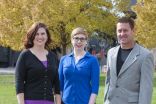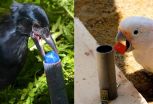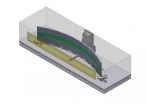Stanford professor discusses techniques for minimizing environmental impacts of fracking
2014-12-15
(Press-News.org) Natural gas from hydraulic fracturing generates income and, done well, can reduce greenhouse gas emissions, air pollution and water use compared to coal and even nuclear energy. However, widespread use of natural gas from fracking could slow the adoption of wind, solar and other renewables and, done poorly, release toxic chemicals into the environment.
Robert Jackson, the Kevin and Michelle Douglas Professor of Environment and Energy at the Stanford School of Earth Sciences, will discuss how to minimize the water and air impacts of fracking and other unconventional energy-extraction techniques on Dec. 18 at the American Geophysical Union's Fall Meeting in San Francisco. The talk, titled "Minimizing the Water and Air Impacts of Unconventional Energy Extraction," takes place at 2:55 p.m. PT, at the Moscone Convention Center in Moscone West, Room 3018.
"Switching from coal to natural gas for electricity generation will reduce sulfur, nitrogen, mercury and particulate pollution regionally," said Jackson, a senior fellow at the Stanford Woods Institute for the Environment and Precourt Institute for Energy. "But natural gas extraction can also increase volatile organic compounds and other air toxins locally, creating a potential health threat. One key message is that best practices matter a lot for environmental stewardship, and some companies have stronger best practices than others."
Based on research to date, primary threats to water resources come from surface spills, wastewater disposal and drinking-water contamination through poor well integrity. Jackson will discuss recently published and new data on water contamination in the Marcellus and Barnett shales of Pennsylvania and Texas, respectively.
Natural gas power plants typically emit less carbon dioxide, a major contributor to global warming, than coal-fired plants. But methane, the main ingredient in natural gas, is 34 times more effective at trapping heat than carbon dioxide over a 100-year time scale, according to a recent report by the Intergovernmental Panel for Climate Change. Jackson and his colleagues have found that methane leakage is a significant problem in the U.S. natural gas industry.
According to Jackson, critical needs for future research on unconventional energy extraction include data on the impact of greenhouse gases and air pollution on ecosystems and human health, the potential contamination of surface and groundwater from drilling and spills, and the frequency of well-integrity failures.
INFORMATION:
ELSE PRESS RELEASES FROM THIS DATE:
2014-12-15
Recent international climate talks have focused on the potential of reforestation and afforestation - planting trees in an area where there was no forest previously - to slow global warming. Increasingly, though, science is showing that planting more trees and increasing forest conservation can provide benefits beyond carbon storage, and that carbon-centric accounting is, in many cases, insufficient for climate mitigation policies.
Robert Jackson, the Kevin and Michelle Douglas Professor of Environment and Energy at the Stanford School of Earth Sciences, will discuss ...
2014-12-15
Runoff from rainstorms in big cities can represent both threats and opportunities. Too much runoff in the wrong places causes flooding. Too little rainwater in the right places leads to dried-up creeks and rivers. Water that washes up pollution from city streets can dirty downstream watersheds. Figuring out the best solutions to these problems requires lots of data - data that are easy to get in highly developed countries, but much scarcer in others.
On Dec. 15 at the American Geophysical Union Fall Meeting in San Francisco, Perrine Hamel, a postdoctoral scholar with ...
2014-12-15
Stanford scientists have found evidence that sections of the fault responsible for the 9.0 magnitude Tohoku earthquake that devastated northern Japan in 2011 were relieving seismic stress at a gradually accelerating rate for years before the quake.
This "decoupling" process, in which the edges of two tectonic plates that are frictionally locked together slowly became unstuck, transferred stress to adjacent sections that were still locked. As a result, the quake, which was the most powerful ever recorded to hit Japan, may have occurred earlier than it might have otherwise, ...
2014-12-15
WASHINGTON, Dec. 15, 2014--Credit card fraud and identify theft are serious problems for consumers and industries. Though corporations and individuals work to improve safeguards, it has become increasingly difficult to protect financial data and personal information from criminal activity. Fortunately, new insights into quantum physics may soon offer a solution.
As reported in The Optical Society's (OSA) new high-impact journal Optica, a team of researchers from the Netherlands has harnessed the power of quantum mechanics to create a fraud-proof method for authenticating ...
2014-12-15
A survey of more than 300 college students reveals that college students who use "fake weed" or synthetic THC are most likely to have tried the drug because they were curious. Rebecca Vidourek, a University of Cincinnati assistant professor of health promotion and assistant director of the Center for Prevention Science; Keith King, a UC professor of health promotion and director of the Center for Prevention Science; and Michelle Burbage, a graduate student and graduate assistant for UC's Health Promotion and Education Program, published their findings in the current issue ...
2014-12-15
This news release is available in French. "Media reports about behavioural genetics unintentionally induce unfounded beliefs, therefore going against the educational purpose of scientific reporting," writes the University of Montreal's Alexandre Morin-Chassé, following his study of 1,500 Americans. "Among other things, we wanted to know if the public understood (or misunderstood) popular science articles about a new research field, genopolitics, and whether this popularization indeed helped people have an informed opinion on human genetics," Morin-Chassé explained.
The ...
2014-12-15
This news release is available in German. The ways animals play with inedible objects may be precursors of functional behaviors such as tool use and goal directed object manipulation. For these reasons, species of high technical intelligence are also expected to play intensely with inanimate objects when no obvious goal is pursued. Within object play, combinatory actions are considered a particularly informative trait in animals as well as human infants: Children start bashing two objects together when they are about 8 months old, at 10 months, they combine toys with ...
2014-12-15
A study conducted by University of Granada scientists (from the Physiology, Obstetrics and Gynaecology Departments) and from the San Cecilio Clinical Hospital (Granada) has demonstrated that delaying the cutting of the umbilical cord in newborns by two minutes leads to a better development of the baby during the first days of life.
This multidisciplinary work, published in the prestigious journal Pediatrics reveals that the time in cutting the umbilical cord (also called umbilical cord clampling) influences the resistance to oxidative stress in newborns.
For this research, ...
2014-12-15
In medicine, X-rays provide high-resolution images of our insides to help doctors make a definitive diagnosis. Industry uses X-rays, too - as a reliable, non-destructive way of seeing what's hidden on inside materials and components and to check for cracks or irregularities. However industry additionally draws upon different technologies that are not used in the medical field. Whereas medical X-ray machines have been specifically designed for human test subjects, industrial X-ray machines are used to analyze objects that vary much more in their size and material composition. ...
2014-12-15
MANHASSET, NY -- Molecular Medicine, a peer-reviewed biomedical journal published by the Feinstein Institute Press, published the results of a new study reporting clinically significant pain reduction in type 2 diabetic patients. In an exploratory study conducted by Araim Pharmaceuticals, a biotech company developing novel treatments for chronic diseases, investigators also observed improvements in metabolic control in patients administered ARA 290. ARA 290 is a peptide engineered to activate the innate repair receptor, a receptor discovered by Araim scientists, which is ...
LAST 30 PRESS RELEASES:
[Press-News.org] Stanford professor discusses techniques for minimizing environmental impacts of fracking



